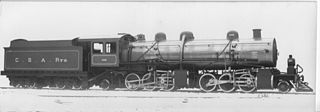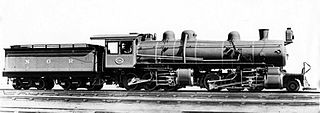
A Mallet locomotive is a type of compound articulated steam locomotive, invented by the Swiss engineer Anatole Mallet (1837–1919).

Under the Whyte notation for the classification of steam locomotives, a 2-10-4 locomotive has two leading wheels on one axle, usually in a Bissel truck, ten coupled driving wheels on five axles, and four trailing wheels on two axles, usually in a bogie. These were referred to as the Texas type in most of the United States, the Colorado type on the Burlington Route, and the Selkirk type in Canada.

Under the Whyte notation for the classification of steam locomotives, 4-8-4 represents the wheel arrangement of four leading wheels on two axles, eight powered and coupled driving wheels on four axles and four trailing wheels on two axles. The type was first used by the Northern Pacific Railway, and initially named the Northern Pacific, but railfans and railroad employees have shortened the name since its introduction. It is most-commonly known as a Northern.
Under the Whyte notation for the classification of steam locomotives, 2-10-2 represents the wheel arrangement of two leading wheels, ten powered and coupled driving wheels, and two trailing wheels. In the United States and elsewhere the 2-10-2 is known as the Santa Fe type, after the Atchison, Topeka and Santa Fe Railway that first used the type in 1903.

In the Whyte notation for the classification of steam locomotives by wheel arrangement, a 2-8-8-0 is a locomotive with a two-wheel leading truck, two sets of eight driving wheels, and no trailing truck.

Under the Whyte notation for the classification of steam locomotives, a 4-8-8-2 is a locomotive with four leading wheels, two sets of eight driving wheels, and a two-wheel trailing truck.

Under the Whyte notation for the classification of steam locomotives by wheel arrangement, a 2-6-6-2 is a locomotive with one pair of unpowered leading wheels, followed by two sets of three pairs of powered driving wheels and one pair of trailing wheels. The wheel arrangement was principally used on Mallet-type articulated locomotives, although some tank locomotive examples were also built. A Garratt locomotive or Golwé locomotive with the same wheel arrangement is designated 2-6-0+0-6-2 since both engine units are pivoting.
Under the Whyte notation for the classification of steam locomotives, a 2-8-8-8-4 has two leading wheels, three sets of eight driving wheels, and four trailing wheels.

Under the Whyte notation for the classification of steam locomotives by wheel arrangement, 2-6-6-0 is a locomotive with one pair of unpowered leading wheels, followed by two sets of three pairs of powered driving wheels and no trailing wheels. The wheel arrangement was principally used on Mallet-type articulated locomotives. Some tank locomotive examples were also built, for which various suffixes to indicate the type of tank would be added to the wheel arrangement, for example 2-6-6-0T for an engine with side-tanks.

The Santa Fe class 3450 consisted of ten 4-6-4 "Hudson" type steam locomotives built by the Baldwin Locomotive Works in 1927. Built as coal-burners, they were later converted to oil-burning during the 1930s. At the same time, the locomotives were given 79-inch (2,007 mm) driving wheels instead of their original 73-inch (1,854 mm), and the boiler pressures increased from 220 to 230 lbf/in2. Combined, these changes reduced the starting tractive effort from 44,250 to 43,300 lbf, but increased the top speed and efficiency. Their early service was in the Midwest, between Chicago and Colorado; later, some were assigned to service in the San Joaquin Valley of California between Bakersfield and Oakland.
A triplex locomotive was a steam locomotive that divided the driving force on its wheels by using three pairs of cylinders to drive three sets of driving wheels. Any such locomotive will inevitably be articulated. All triplex locomotives built were of the Mallet type, but with an extra set of driving wheels under the tender. The concept was extended to locomotives with four, five or six sets of drive wheels. However, these locomotives were never built, except for one quadruplex locomotive in Belgium.

The South African Railways Class MA 2-6-6-0 of 1909 was a steam locomotive from the pre-Union era in the Natal Colony.
The South African Railways Class MC 2-6-6-0 of 1912 was a steam locomotive.

The South African Railways Class MC1 2-6-6-0 of 1914 was a steam locomotive.

The South African Railways Class MD 2-6-6-2 of 1910 was a steam locomotive from the pre-Union era in Transvaal.
The South African Railways Class MG 2-6-6-2 of 1911 was a steam locomotive from the pre-Union era in Transvaal.

The South African Railways Class MH 2-6-6-2 of 1915 was an articulated Mallet-design steam locomotive.
Under the Whyte notation for the classification of steam locomotives, a 2-8-8-8-8-2 has two leading wheels, four sets of eight driving wheels, and two trailing wheels. Because of its length, such a locomotive must be an articulated locomotive. It is not longer than a normal articulated; the fourth set of drivers is located under the tender.
Under the Whyte notation for the classification of steam locomotive wheel arrangements, a 4-4-6-2 is a locomotive with two pairs of leading wheels, one set of four driving wheels, a second set of six driving wheels, and a pair of trailing wheels.
A multiplex locomotive is a steam locomotive that divides the driving force on its wheels by using multiple pairs of cylinders to drive multiple driving wheel set groups. Such a locomotive will necessarily articulated if it has more than two sets of driving wheels. There were locomotive projects with three, four, five or six sets of drive wheels. However, these locomotives were never built, except for four triplex locomotives in the United States and one quadruplex locomotive in Belgium.












